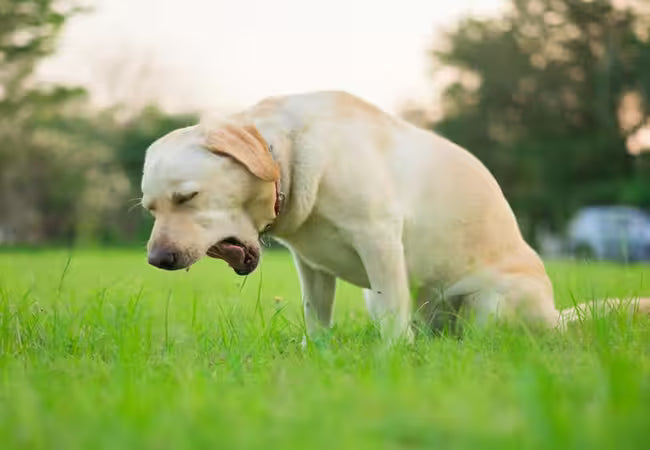2025 Vet Guide: Why My Dog Is Throwing Up Blood – Causes, Care & When to Act 🐶🩸

In this article
2025 Vet Guide: Why My Dog Is Throwing Up Blood – Causes, Care & When to Act 🐶🩸
By Dr. Duncan Houston BVSc
Seeing blood in your dog's vomit is alarming. Hematemesis—or bloody vomit—can indicate anything from minor irritation to life-threatening disease. Let’s break down causes, when to act fast, diagnostics, and care strategies. 💡
🔍 1. Recognizing Hematemesis
- Bright red blood: Likely fresh bleeding from the mouth, esophagus, or upper stomach.
- Dark, “coffee-ground” blood: Indicates digested blood from the stomach or intestines.
- Small specks: Suggest minor irritation or superficial injury.
⚠️ 2. When It’s an Emergency
Seek veterinary care immediately if:
- Large amounts of blood (pure hemorrhage) are present.
- Blood is dark/coffee-ground in appearance.
- Signs of shock: pale gums, collapse, rapid heartbeat, weakness.
- Puppies or small dogs are vomiting blood—quick deterioration is possible.
- Concurrent symptoms like diarrhea, lethargy, abdominal pain, or fever are present.
🩺 3. Common Causes
- Oral/esophageal irritation: From chewing, foreign objects, bone fragments—bright red blood.
- Gastritis and ulcers: Inflammation or ulcers in the stomach lining—coffee-ground vomit, pain, appetite loss.
- Hemorrhagic gastroenteritis (HGE): Sudden vomiting and bloody diarrhea—small breeds are at risk.
- Foreign body/obstruction: Blockage causing mucosal damage and bleeding.
- Toxins and poisons: NSAIDs (ibuprofen), rat poison, plants—cause ulcers, bleeding, organ damage.
- Cancer: GI tumors or hemangiosarcoma may bleed internally.
- Clotting disorders: ITP, rodenticide ingestion—spontaneous bleeding, including hematemesis.
- Liver/kidney disease: Organ dysfunction can lead to secondary gastric bleeding.
🧪 4. Veterinary Diagnostics
- Physical exam, vital signs, oral and abdominal palpation.
- Bloodwork: CBC, biochemistry, clotting profile, organ function.
- Urinalysis and fecal tests for infection and parasites.
- X‑rays and ultrasound to locate foreign objects, masses, and obstructions.
- Endoscopy or exploratory surgery if needed.
🛠️ 5. Treatment Options
- Stabilization: IV fluids, blood transfusion for anemia or shock.
- Medications: Antiemetics (maropitant, ondansetron), gastroprotectants (sucralfate, famotidine, omeprazole).
- Antibiotics: If infection or toxin exposure is suspected.
- Foreign body removal: Surgical or endoscopic extraction.
- Toxin treatment: Activated charcoal, vitamin K for anticoagulant ingestion.
- Ulcer management: Treat the underlying cause and protect the GI lining.
- Tumor therapy: Surgery, chemo, or palliation based on diagnosis.
🏡 6. Home Care & Ongoing Support
- Move to bland diet (chicken & rice or prescription GI diets) after vet approval.
- Small, frequent meals; avoid stress and exercise early on.
- Track vomiting, stool, appetite, medications, and fluid intake using tools.
- Use apps like Ask A Vet, Woopf & Purrz to log symptoms and follow-up care.
📚 FAQs
Q: My dog vomited a little blood once—should I panic?
If it’s just a small spot and your dog is otherwise well, monitor closely. But always consult your vet to rule out serious concerns.
Q: Is coffee-ground vomit worse?
Yes. Dark vomit suggests upper GI bleeding and requires immediate veterinary evaluation.
Q: Can I stop them from vomiting with home remedies?
No. Blood vomit always warrants vet attention. Delay might worsen the underlying condition.
💬 Owner Insight
“Our terrier vomited dark flecks of blood after eating a bone. Vet found a small ulcer—treatment and bland diet helped, and he’s back to normal!”
🏁 Final Thoughts from Dr Houston
Vomiting blood is never normal and always requires evaluation. It may stem from many causes—from minor stomach irritation to life-threatening disease. With prompt vet care, diagnostics, and support tools like Ask A Vet, Woopf & Purrz, you can guide your dog toward recovery in 2025 and beyond. 💙🐾
Download the Ask A Vet app for instant triage, symptom tracking, and professional advice. 📱
AskAVet.com – Helping your dog feel their best—one day at a time.






